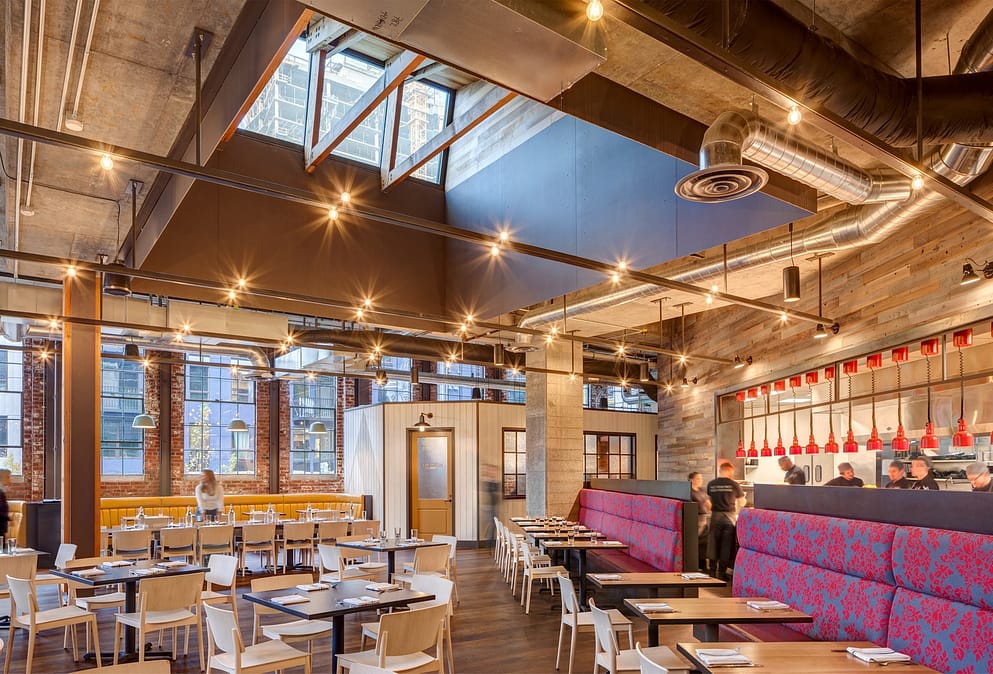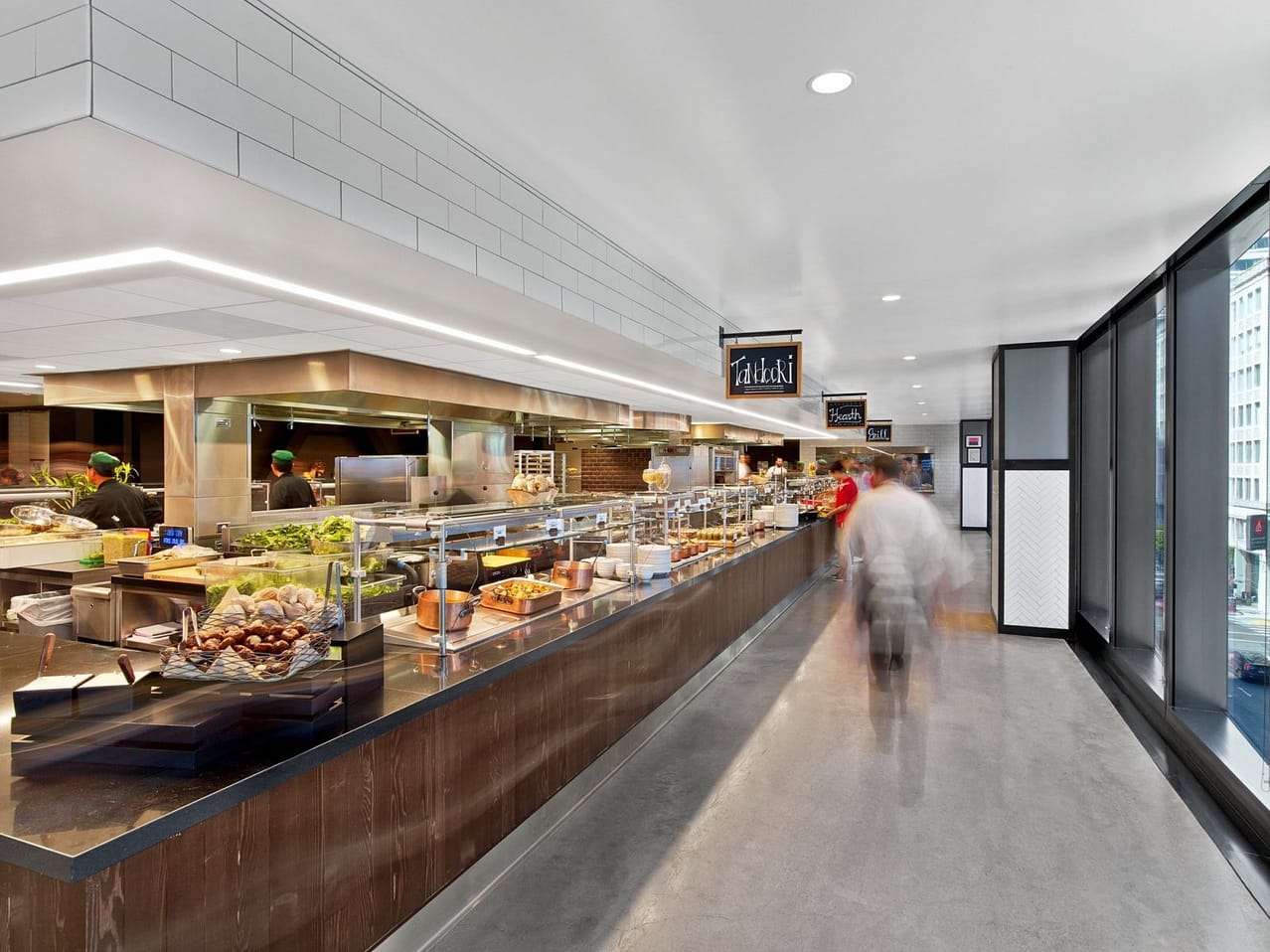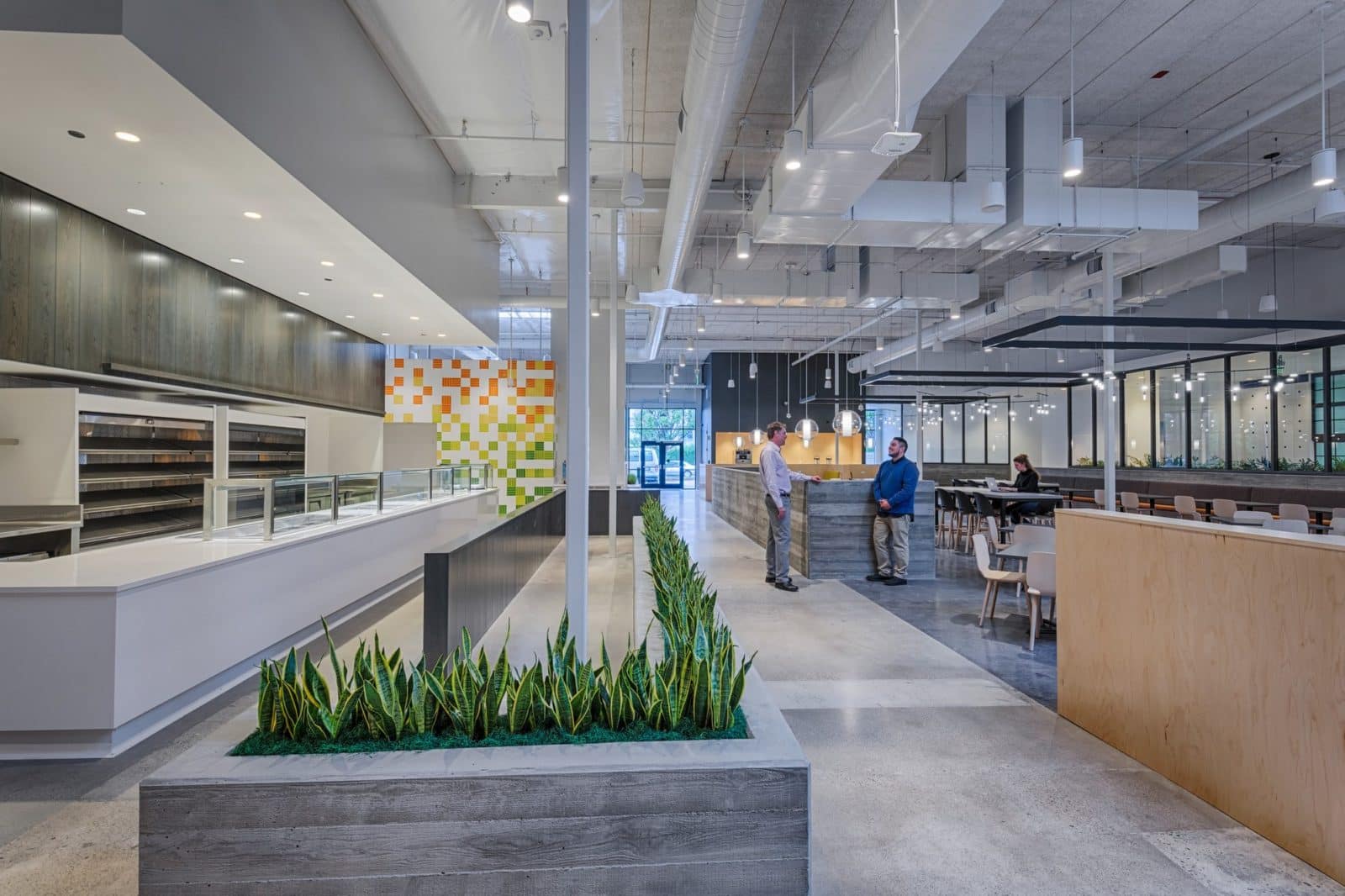By Patrick Chatfield, AIA, NCARB, OAA, MRAIC | Design Director
&
Melissa Panara, NCIDQ, LEED AP | Design Director
IA Interior Architects recently hosted a roundtable discussion with industry partners looking at how COVID-19 will affect workplace foodservice spaces. The conversation, moderated by IA Interior Architects' Patrick Chatfield, featured IA Design Director Melisa Panara, Regional Commercial Kitchen Design Manager Antonio Rico of Bon Appétit Management Company, Project Manager and Lead Consultant at NGAssociates Nahum Goldberg, and Steve O’Brien, Vice President of Enterprise Sales at Fooda.

As teams return to the office, foodservice designers must investigate how wayfinding can support social distancing initiatives. Confidential Client, Seattle. Photography © Sherman Takata.
The COVID-19 crisis is causing major shifts in the way we work and how we experience the world. The workplace design world is abuzz with post-COVID discussions about how the workplace should be readied culturally, physically, and administratively for employees to return. These discussions, however, are largely centered around the workplace proper. At IA Interior Architects, as a part of our integrated design philosophy, we work with consultant and vendor teams, all of whom are grappling with changes as they relate to the COVID-19 crisis. We asked our internal subject matter experts in addition to foodservice operators, design consultants, and caterers how they expect foodservice spaces will be affected in both the immediate and long terms.
Food Preparation
As a result of the recent crisis, user teams are faced with new requirements for personal space and surface cleanliness that is forcing them to rethink existing food preparation models. “There’s no cookie cutter approach to any client model,” says Steve O’Brien, Vice President of Enterprise Sales at Fooda, a national workplace food program provider. “The good news about food preparation is that it’s been regulated pretty well by the government prior to this current situation,” he continues. “So much of what we and other organizations are being asked to do are really just add-ons and accents and enhancements to what is already in place from an HACCP and from a food production standpoint.” While this means that many teams won’t have to develop post-COVID strategies completely from scratch, IA and its partners and clients are preparing for drastic changes in how workplace foodservice teams prepare meals—taking a hard look at everything from staff scheduling to equipment and infrastructure. Antonio Rico, Regional Commercial Kitchen Design Manager for Bon Appétit, summarizes the wide array of questions teams are having to examine this way:
“The immediate need is looking at what that path looks like from the back door of the kitchen all the way through the front of house and identifying the risks. How do we make sure employees are healthy and how do we keep guests healthy? Do we have employees wear street clothes and shoes in the kitchen? Do we provide them individually sealed uniforms? What does that changing room process look like, and how does that factor into the workday? Do our back of house spaces have enough ventilation, and are we providing enough space in spaces to prepare food safely without cross contamination and running into each other? We’re taking a look at staggering who does what throughout the day and how that impacts menus—there are a lot of questions we have to address from a wide variety of angles.”

“We’re seeing a lot of organizations taking a “wait and see” approach until things become clearer when it comes to identifying what the actual health challenges are, what the design requirements might be in the future, and what the return to the workplace looks like,” says Nahum Goldberg of NGAssociates. Most experts are predicting that, at least initially, most foodservice spaces will be seeing reduced menus, and A/B scheduling of food staff. LinkedIn, San Francisco.
Technology
Ultimately, he and a number of other experts in the field believe that technology is going to play a large role in addressing these concerns. “The back of house is going to be the first thing people always try to value-engineer; it's the most expensive part of a food and beverage space,” continues Rico. “There are a lot of pieces of equipment that are essential to food safety that will see less push back on cost — the cost of the sneeze guard, the cost of the blast chiller outweigh the cost of sick employees and customers. These are essential pieces of equipment that are going to be at the forefront of safety.”
Manufacturers are in a practical arms race to develop the equipment that will make food preparation and ordering as touch-free and hygienic as possible, and some of it won’t be located in or near dining areas. “Rather than ordering in-person where bottlenecks can be created, apps and gesture technology (unlike kiosks) can allow users to order food safely while maintaining social distancing and without touching the same surfaces,” says Melissa Panara, Design Director at IA Interior Architects. “As designers, we try to look at the problem from different angles, and we’re seeing that robotics for food delivery and preparation is getting some serious consideration.” As teams finalize plans for returning to the office, part of the difficulty in planning is determining where to make short- versus long-term investments.
Flexibility as a Short-Term Response
Rather than investing in long-term, permanent solutions, many user groups are viewing the COVID-19 response as a short-term challenge and designing for flexibility. Nahum Goldberg, Project Manager and Lead Consultant for NGAssociates, believes this to be one of the more common approaches. “Many teams are moving to a model that embraces the flexibility of space. We’re designing full-service stations that replace salad bars and can be full-service day one and perhaps return to self-service.”
Fooda's Steve O’Brien sees the innate benefits in a tiered return to the workplace for the foodservice user experience. “We’re not going to be seeing everyone back at the office all at once. Everything’s going to be flexible and tiered, so that will create opportunities for fear to diminish, but to make the most of that opportunity, providers are going to have to make sure their models are agile.”
“What we’re seeing is that 99% of clients want to get rid of all self-service spaces like salad bars, at least on a temporary basis.”—Steve O’Brien, Fooda
Materiality and Intuitive Design
Nahum Goldberg (and the majority of the foodservice experts IA has consulted with) consider it critically important that the visibility of food preparation is maintained. “The creative challenge that we’ll all be facing is how we maintain authentic food preparation upfront,” he says. “It’s not going away, and it’s an important part of the user experience.”

Many teams are having to weigh the benefits of permanent vs. temporary wayfinding strategies to help enforce social distancing. Photography © Marco Zecchin. Confidential client, Mountainview, CA.
A Time of Opportunity
“This is an opportunity to return back to the basics of why we all fell in love with food service” reflects Rico. He, like many in the industry, sees potential real estate cost-savings on the horizon; when combined with the immediate needs of foodservice spaces, he predicts something of a foodservice renaissance in the near future. “I’m super optimistic about the future of foodservice. We were discussing many of these concepts six months ago to solve various issues in the foodservice industry—robotics to address labor shortage, logistics solutions for centralized food production, UV lights for disinfection, etc. At the time they were considered unrealistic or too expensive, but we can dust these ideas off and take a serious look at them again. We can also take lessons learned from the healthcare industry, the construction industry, and the airline industry to help transform the way that we are operating and designing our food and beverage spaces.”

